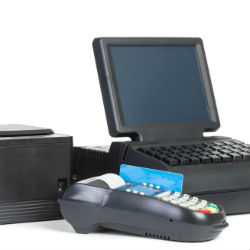Answer these simple questions and we will find you the BEST prices
Which type of solar quotes do you need?
It only takes 30 seconds
100% free with no obligation

Get up to 4 quotes from our selected suppliers by filling in only 1 form

Save money by comparing quotes and choosing the most competitive offer

Our service is 100% free and with no obligation
- Market-Inspector.co.uk
- EPOS Systems
- ePOS Hardware
EPOS Hardware
What Is ePOS Hardware?
Apart from an efficient software, it is also important to have an excellent hardware to be able to enjoy all the benefits of ePOS systems. Hardware will have a huge impact on the efficiency of a store.
It is necessary to have high quality material to avoid printer jams or computer bugs, as it will allow vendors to stay clear from frustrated customers because of a long waiting time.
Existing hardware can often be used with a new ePOS software but it has to be checked as it might not be compatible. Some software are suitable with only Mac or iPad, or on the contrary, only with PC.
Software programs offer many opportunities and features to the business, they are adaptable to different sectors and are very powerful. It is important to decide which software to use before choosing hardware.
To get professional advice concerning ePOS hardware, please fill out the form and enjoy our free service. According to the needs of your company, our suppliers will provide you with 4 non-binding quotes customised to your business.
What Are ePOS Hardware Devices?

Hardware is all the physical equipment needed for the POS. Devices are really diverse, many options are available for each accessory.
Reliability is the most important criteria to take into consideration- equipment has to be robust, since it will be used everyday. A renown brand with good warranties could be favoured as it will probably not run out of business.
On the other hand, cheap devices on the market should be avoided.
Here we list and explain the main equipment needed for a POS system. As everything is connected to a monitor, this is the first thing to choose.
Monitor
To decide which monitor will be needed in a store, you need to know how much space you have available for placing the screen. Usually a large screen is better, but if the space is limited then a 15” flat panel could also work.
The space available could also determine if a touchscreen is needed or not. As this kind of equipment allows one to control the mouse cursor with fingers, it saves space with the elimination of the mouse and the keyboard. Also, a touchscreen is often simpler, but it has to be robust as it will be exposed to scratches and dirty hands.
Credit card machine
If a mobile POS is the chosen option for the store, then you need a wireless credit card reader that can be connected to a phone or a tablet. However, most of the times a credit card machine will be needed.
The most common way to process a card is with a chip and PIN transaction. The card will have to be placed in the terminal and the customer will have to enter his PIN code. By receiving payments this way, sellers can prove that the buyer agreed on this transaction.
In any case, before deciding which system to buy, it is important to know how customers will pay. Note than not all systems accept all kinds of credit cards. For example, in general, extra fees will have to be paid in order to accept american express cards.
The cost of the service is also an important factor. Some companies ask for a payment for each transaction, some ask for a monthly fee while other companies ask for both. It is important to calculate approximately how many payments the store will receive per month as this will show if a monthly fee is more profitable or not.
Keep in mind that providers can sometimes lock their customers into a contract with a penalty for early termination. Also, remember that the time it takes for vendors to receive the money into their bank accounts can differ depending on the provider. In the best case, the transfer takes one day.
Barcode scanner

This device saves valuable time, as information can be scanned and vendors don’t have to type it manually. Bar code readers interpret the lines and translate it into regular characters before sending it to a computer. Customers can check-out faster and you can benefit from improved customer service.
There are four main types of scanners. Not all types supporting all bar code symbols; the scanner chosen has to reed the type of symbol used in the store.
The most common one is the laser scan because it works with uneven surfaces and it can scan from relatively long distances.
Other options are also available as: a Pen Type Scanner that is less expensive but harder to use, a CCD (Charged Coupled Device Scanner) that is reliable but can only read scan on close and flat items and the last one is Linear Imager Scan that is fast, affordable and can be used in bright sunlight.
To be able to choose the right one, the store’s owner needs to know which options are available and which one is the most appropriate: portable or fixed barcode, wireless or with a cable, high density reader for small items, long ranges scan, uneven scan, fast scanning, scan under bright sunlight possible.
The scan reader chosen needs to have an interface connection that is available on your computer.
Barcode printer
If the store has a barcode scanner, then it needs a barcode printer to apply labels on the items. Barcode printers vary if thousands or hundreds of labels need to be printed per day. Also, if labels have to be water resistant, exposed to sunlight, in color or exposed to heat then the printer has to be adapted to such features.
Receipt printer
Computer interface connexions have to be checked in order to decide which receipt printer to use. Today, most of the printers are connected via an USB port but it can also be a serial port or a parallel port. The monitor has to have the connexion port available.
Receipt printers also differ in terms of printing resolution, speed, paper cut option feature, and size of the paper. Depending on the store’s type, a small receipt or a full invoice will be needed. Paper rolls have to be easy to change.
Cash drawer
A cash drawer opens when vendors sell an item, as a cash register. It allows the seller to separate bills and coins. To choose the right cash register, the space available has to be taken in consideration, and the possibility to lock it or not.
Other devices
Depending on the store’s activity, it might need more hardware devices. For example, an iPad enclosure, a weighing scale or an electronic VFD pole display screen could be adapted to improve the customer service.
Buying or Renting?
Electronic POS hardware can be bought or rented. In order to rent the devices, a monthly fee will have to be paid. This solution offers a better customer support in case of problems and the provider often keeps the devices up-to-date.
The other option is to buy the ePOS hardware. This solution might be cheaper in the long term but the devices have to be reliable and well maintained. Keeping the systems in good condition can be costly if the supplier doesn’t provide support. Before buying it is important to double-check for how long the supplier offers support after a purchase.
The POS software retailer can be contacted to get important information and recommendations about the compatibility with any hardware devices. Many of the software retailers are also selling hardware devices.
It can be interesting to have the entire POS system from the same vendor, especially for small companies. It could avoid some troubles in having two different retailers blaming each other and unwilling to take the responsibility to fix a problem.
Current Trends
Contactless

Contactless is a new card reader which allows the customer to pay with credit and debit cards just by putting it in front of the machine and without having to enter a PIN code.
This way is faster and could reduce queues. This payment option can be used only for purchases of £20 or less.
NFC (near field communication)
This payment option allows customers to pay with their phones. A special card reader is required but it could be an advantage for a store to offer this service as 47% of the UK population is being eager to use this payment format.
If you need any additional help choosing an ePOS hardware, you can receive up to four free quotes from us. Just fill out the contact form and we will send you quotes with no strings attached.
We strive to connect our customers with the right product and supplier. Would you like to be part of Market Inspector?

